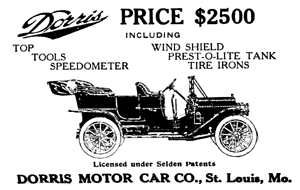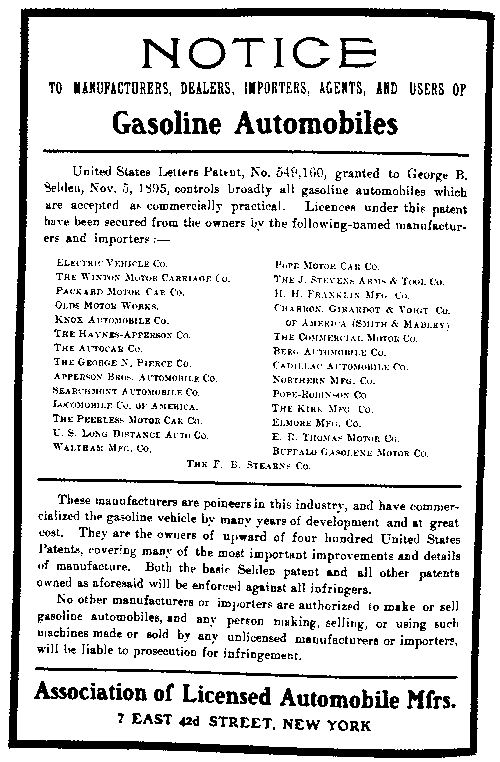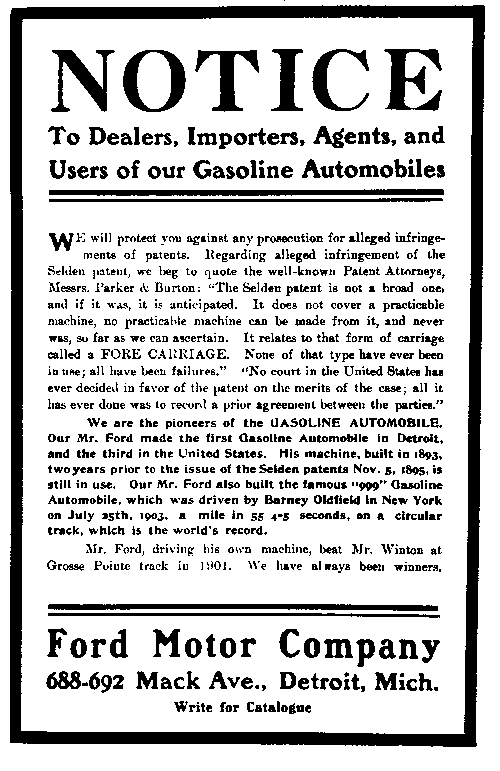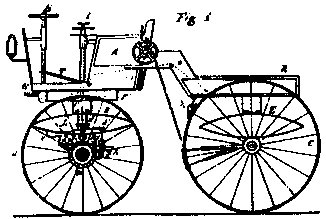George who?
|
|
Road EnginePatent No. 549,160 Inventor: George Selden, Rochester, New York Filed: May 8, 1879 |
This patent represents a forgotten episode in the history of the automobile. The question of who invented the motor car is an open one - Ford, Daimler, Duryea, Cugnot all lay claim to the title of "Father of the Automobile" - but you will seldom hear the name of patent attorney George Selden of Rochester, New York, mentioned.
Selden applied for a patent on the "Road Engine" in 1879. Sensing that the time was not right for a horseless carriage, he delayed issuance of the patent until 1895, by which time a young automobile industry was growing in the USA. Although he had no interest in manufacturing his invention, he was very interested in benefiting from it. Under threat of suit, almost all of the manufacturers took out licenses from Selden, or from the Association of Licensed Automobile Manufacturers (ALAM), to whom he sold the patent. In fact, on most cars built during the next ten or fifteen years you will find a small brass plaque reading "Manufactured under Selden Patent."

An ad for the 1910 Dorris
with a Selden license notice
There was one notorious holdout, a young manufacturer named Henry Ford. Selden sued Ford (among others), and the lawsuit dragged on for nearly eight years. During that time the ALAM took out magazine ads, threatening to sue anyone who bought an unlicensed car - some advised people "don't buy a lawsuit with your new automobile." Here's a sample ALAM advertisement, claiming that the Selden patent was so broad that any practical car must infringe:

Ford countered with his own ads, disputing the patent, and offering to indemnify anyone who was actually sued by the ALAM:

Although the Selden patent was upheld at the trial level, Ford appealed. Finally, only one year before it was to expire, the appeals court declared the Selden patent to be invalid, except as to cars powered by the Brayton-type external-compression two-stroke engine described in the patent, which Selden's own expert testified at trial was not actually used by anyone making cars at that time.
It was reported that at one point during the trial, an automobile race was being organized outside the windows of the courthouse. Ford's lawyer looked out the window and said to the judge, "your honor, I see a Winton, and a Duryea, and many Fords out there - but not one single Selden!"
He was right, of course - Selden was a patent attorney, not a car builder. In the course of the suit Selden did build a car according to the patent (for the first time, apparently), and it managed to stagger along under its own power for a short while before expiring.
Selden died at age 78 on January 17, 1922. He is buried in Rochester, New York.
Read it for yourself
Click Here for a full copy of
the Selden Patent (PDF format)
A series of e-mails from Doug Harword, a reader of this site, offers an insight into the Selden licensing program. This page originally said that Henry Ford was the only manufacturer who wouldn't take a license - that isn't so, as he points out:
I was just doing a little research on the Selden patent and came across a bit about it on your website.
Actually, there were dozens of manufacturers who did not get licenses. Selden sued some of them and won, but still, many refused or simply didn't bother. For details, you can compare the list in Selden's ads with other information contained in old Horseless Age magazines.
Ford won applause for openly defying Selden and advertising his defiance in such a manner that Selden couldn't ignore the threat. (Ford was obviously itching to for a fight).
I have been grazing through a collection of horseless age magazines from the turn of the century...have been finding more and more accounts of various Selden suits. There was a French concern ...Panhard...which was sued at the same time as Ford, and the two companies apparently joined hands (or at least discovery motions, since there is a reference to Ford's asking for a delay in the trial so that it could translate some documents).
Before Ford egged on the Selden people, Winton, which was a fine manufacturer, set a couple speed records etc., was sued by Selden. Winton didn't have a lot of money, and found several manufacturers to join. The horseless age urged everyone to, but they didn't...this was in about 1903, and despite Winton making the same basic arguments Ford made later, Winton lost and grudgingly coughed up the licensing fee.
Selden not only fought unlicensed gasoline cars, but set up a little subsidiary to go after the electrics. (Saven't seen anything about steam yet, but it was bound to have come up).
For a brief period, when Winton was being sued, an alternative association was established in order to try to break the Selden extortion. I suspect somewhere, buried in all the cases of lawsuits, motions, transcripts, etc., sitting next to the ark of the covenant in some federally-owned cave, there is an incredible book.
Note from Mike Brown, webmaster: If Selden was going after electric and steam manufacturers, the effort would have been doomed to failure, at least if it was this patent they were trying to enforce. All of the claims in the Selden patent required a "liquid hydrocarbon gas-engine of the compression type" which would specifically exclude electric or steam autos. (That is, except for claim 4 which said "a hydrocarbon engine applied to the driving axle and having flexible valve or clutch connections located within the steering mechanism, substantially as described", which doesn't seem to describe any car I've ever heard of).
The first suit Selden filed, according to the Horseless Age, was filed in 1900. The prime defendant was the Winton Motor Carriage Company. (There were several others.)
Alexander Winton built bikes in Cleveland, went bust in the bust of 1893, and after a year or two of playing with gasoline engines in his basement - not a good idea - scraped up enough money to build a car, then another. Had a flair for publicity and made the first serious cross-a-chunk-of-the-country trips in 1898, going from Cleveland to New York on roads that weren't in 11 days. The Smithsonian has that first car. It was also the first American car to be delivered to an American customer. Winton didn't plan it, but he and the car arrived on April Fool's Day. A Winton was also the first car to be driven across the North American continent. That was in 1903. Winton later build three "bullet" racers, the second of which, a 17-litre straight-eight, went a mile in less than 84 seconds in 1904. The Winton company made and sold cars up until 1924, the most popular being the Winton Six.
All of the information about Winton comes from Ralph Stein's sadly out-of-print "The American Automobile." As does a bit about the Selden Patent. According to Stein, in 1897 a group of speculators and "street-railway magnates" bought the patent. The same crew owned an electric cab company dubbed "the lead cab trust," in New York. In 1900, when the suit was brought, the electric cab company was operating about 2,000 electric cabs that it built. The cabs weren't any good. Neither were the cabbies. The patent was a much more reliable source of money.
The suit against Winton was filed in US District Court in Buffalo. A "Hydro-carbon association," was formed by manufacturers to fight it. They hired the law firm of Kenyon and Kenyon, who filed a demurrer, lost that skirmish, then went on to lose the battle.
But the administrators of the patent, dba the Association of Licensed Automobile Manufacturers, were remarkably inept. For instance, the same magazine (from 1903) that carries a list of all 24 manufacturers that had been granted licenses in the wake of the success of the suit� including Winton, Pierce, Packard, Knox, Cadillac, Oldsmobile, Peerless, Haynes-Apperson, and Searchmont, carries advertisements for ten manufacturers who hadn't. That list includes the Crestmont, Jones-Corbin, Crestmobile (you supply the brushes), Duryea, Clarkmobile, the American Gasoline Automobile, the Overland, the Brazier, the Covert Chainless, the Elmore, the Stearns. Some of the names have been completely forgotten. But even the most forgotten of the companies were around long enough to raise some money, build something, and advertise it in a national magazine.
On the other hand, the Selden enforcers faced a challenge not unlike those who try to enforce the music anti-piracy laws. In the first decade of the century, there were just too many people who knew, or thought they knew, or learned after a few tries how to build a car. Blacksmiths, machinists, sewing-machine manufacturers, carriage makers, bicycle makers, farmers, gun makers...the list could go on forever. We really were "a nation of tinkerers," and all but the grouchiest of tinkerers couldn't help being smitten with the machine. And most of them didn't see the foggiest reason to ask for permission.
The History of the Automobile site has further details.
Here's another article about the Selden patent, on the Art of Invention site.
Wikipedia has articles on Selden and the ALAM
Go back for more weird and wonderful patents.
